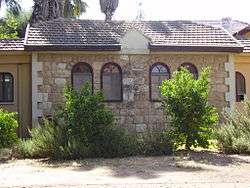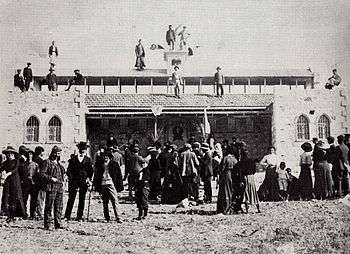Ben Shemen
| Ben Shemen בֶּן שֶׁמֶן | |
|---|---|
 | |
 Ben Shemen | |
| Coordinates: 31°57′14.4″N 34°55′29.64″E / 31.954000°N 34.9249000°ECoordinates: 31°57′14.4″N 34°55′29.64″E / 31.954000°N 34.9249000°E | |
| District | Central |
| Council | Hevel Modi'in |
| Affiliation | Moshavim Movement |
| Founded |
1905 (original) 1952 (re-establishment) |
| Population (2015)[1] | 855 |

Ben Shemen (Hebrew: בֶּן שֶׁמֶן) is a moshav in central Israel. Located around four kilometres east of Lod, it falls under the jurisdiction of Hevel Modi'in Regional Council. In 2015 it had a population of 855.
Etymology
The village's name is taken from Isaiah 5:1;
Let me sing of my well-beloved, a song of my beloved touching his vineyard. My well-beloved had a vineyard in a very fruitful hill.[2]
and also reflects the JNF's planting of olive trees in this area.[3]
History
The moshav was originally founded in 1905, and was one of the first villages established on Jewish National Fund land;[3] the first Jewish National Fund forest is also located in Ben Shemen.[3] According to a census conducted in 1922 by the British Mandate authorities, Ben Shemen had a population of 90 Jews.[4] Which had increased in the 1931 census to 353 residents, in 30 houses.[5] In 1923 it was split in two, with a group of trial farms eventually becoming a separate moshav, Kerem Ben Shemen.
The Ben Shemen Youth Village was established adjacent to the moshav in 1927 and is today a large agricultural boarding school.[6][3]
During World War II, Ben Shemen was the site of a British search for weapons. Similar searches were a common British response to Jewish opposition to the White Paper of 1939.[7] In 1947 Ben Shemen had a population of 75.[3] The village experienced extensive damage during the early days of the 1948 Arab–Israeli war and had to be reconstructed.[3] Immigrants from Romania joined the moshav in 1952. Some houses were built by Bezalel Academy of Art and Design founder Boris Schatz.
Notable residents
References
- ↑ "List of localities, in Alphabetical order" (PDF). Israel Central Bureau of Statistics. Retrieved 16 October 2016.
- ↑ Isaiah Chapter 5 Mechon Mamre
- 1 2 3 4 5 6 Jewish National Fund (1949). Jewish Villages in Israel. Jerusalem: Hamadpis Liphshitz Press. p. 16.
- ↑
- ↑ Mills, 1932, p. 19
- ↑ Chaya H. Roth (16 September 2008). The fate of Holocaust memories: transmission and family dialogues. Macmillan. pp. 83–. ISBN 978-0-230-60607-4. Retrieved 10 April 2011.
- ↑ Anita, Shapira (1992). Land and Power, The Zionist Resort to Force. Chapter 7: Oxford University Press. p. 288.
External links
- Ben Shemen, Cross-Israel Highway: Reproduction of an oil press Israel Antiquities Authority